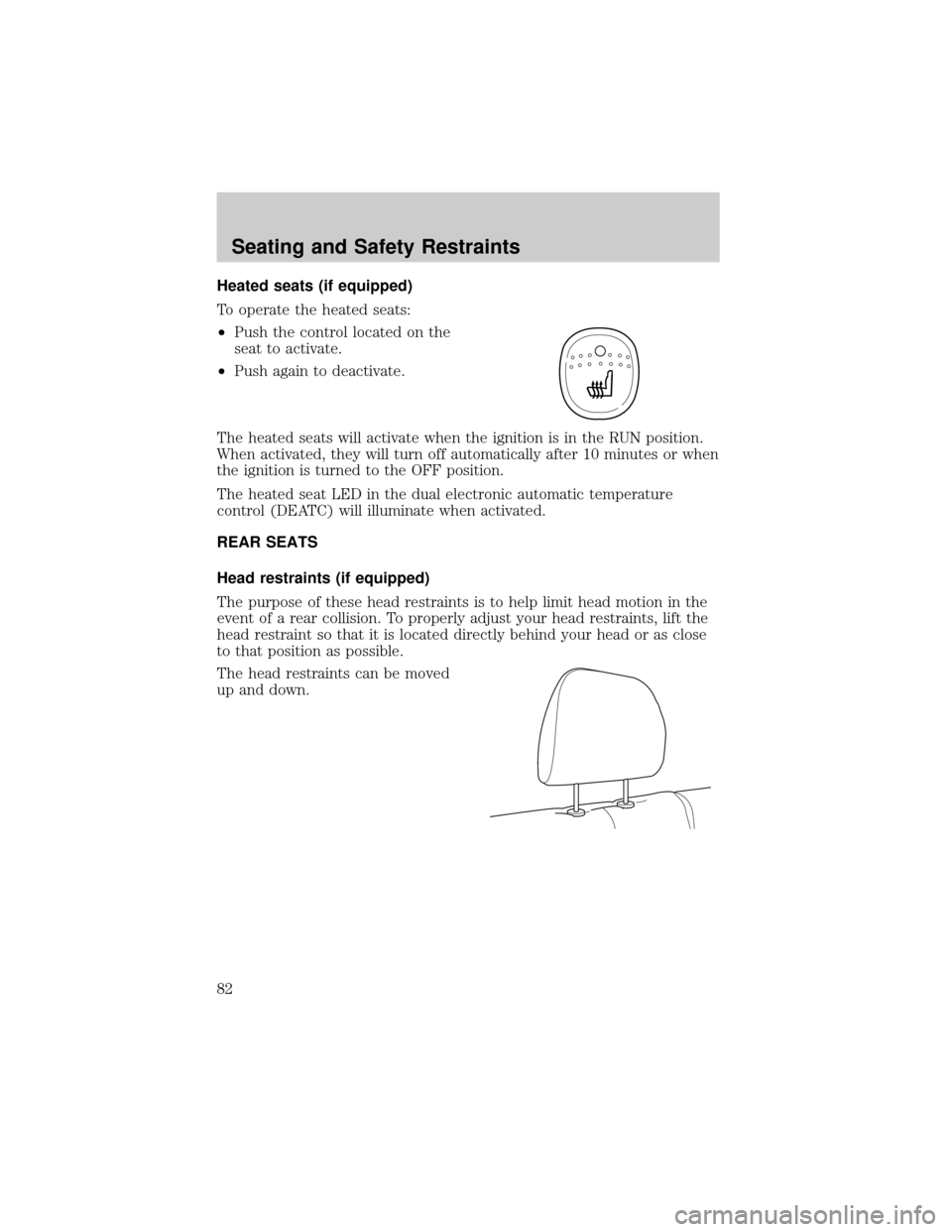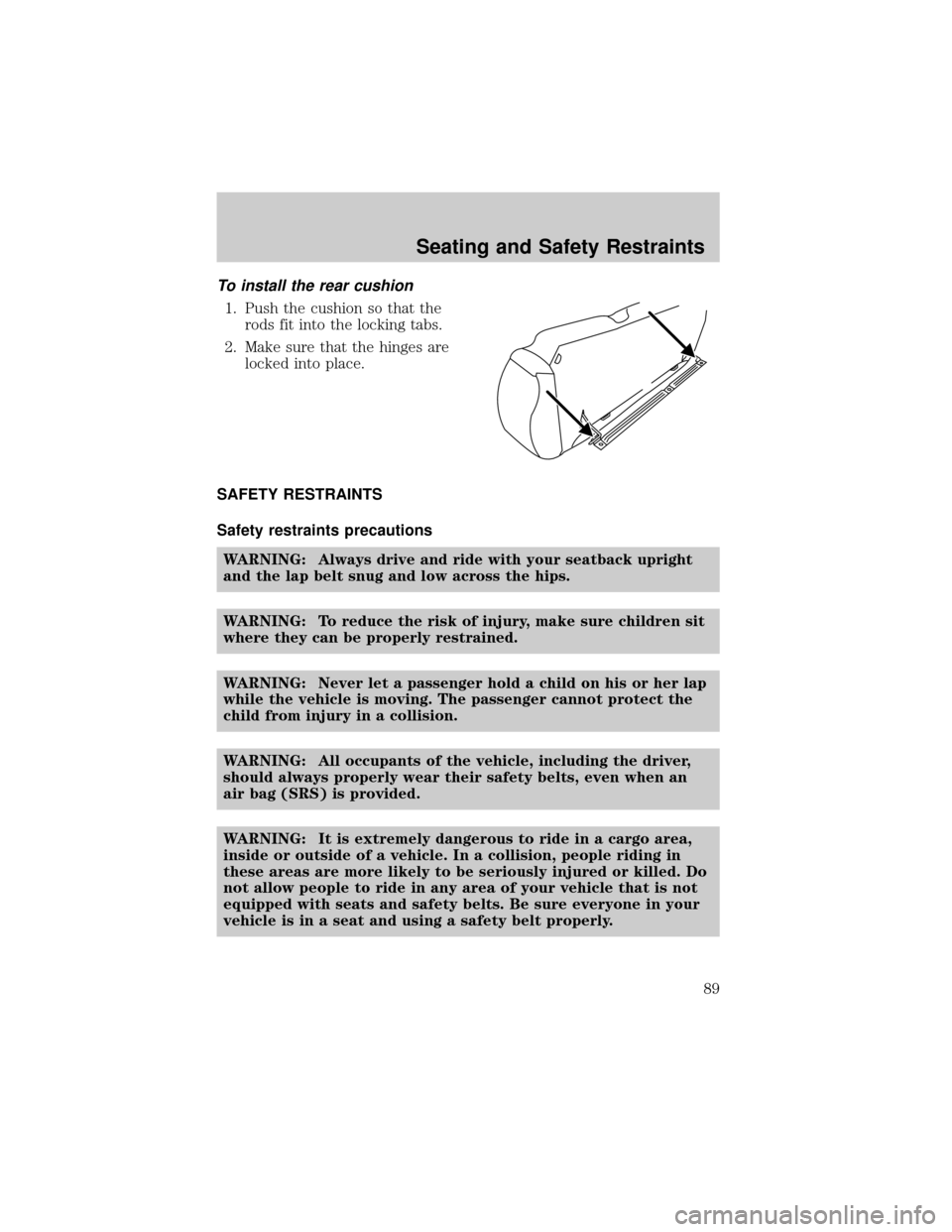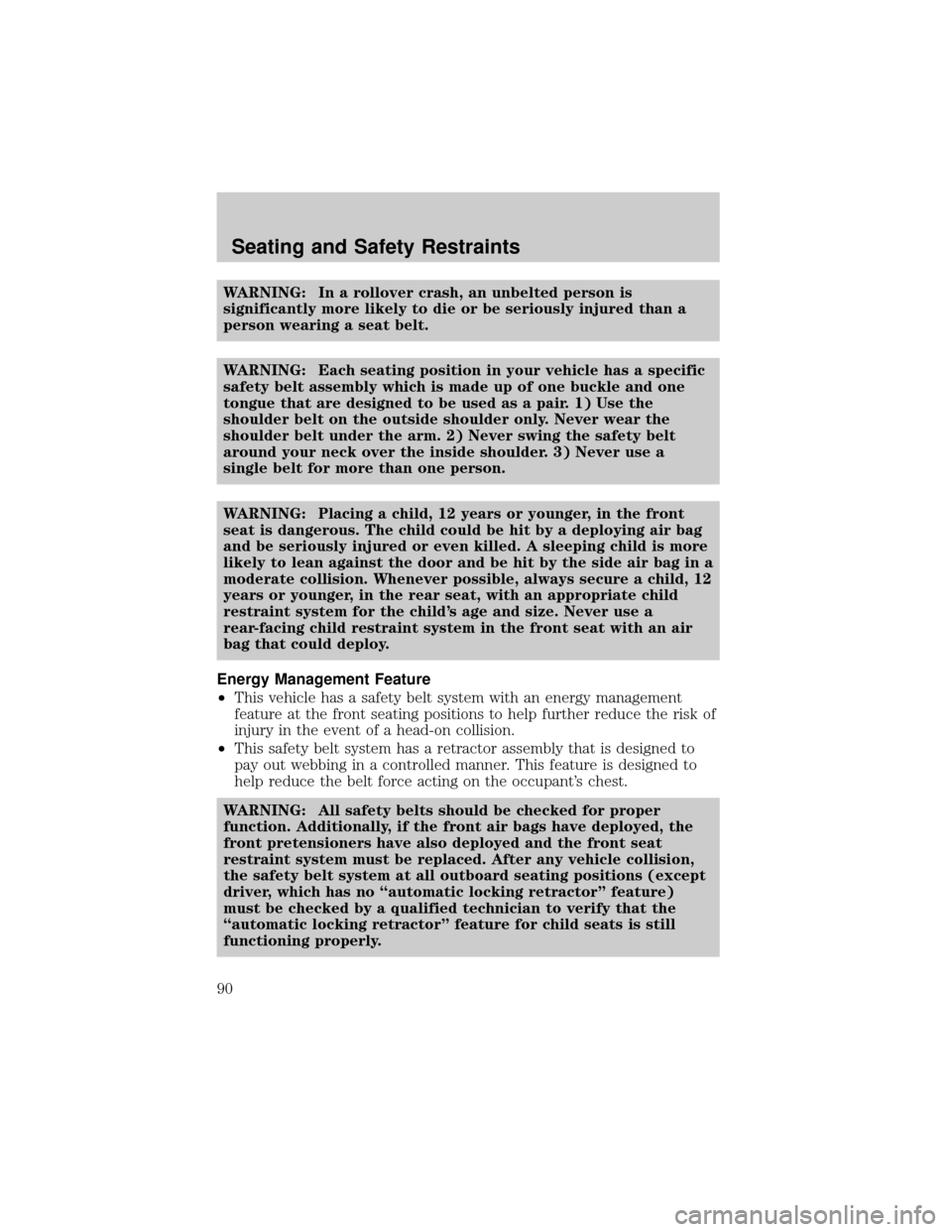MAZDA MODEL TRIBUTE 2003 (in English) Manual Online
Manufacturer: MAZDA, Model Year: 2003, Model line: MODEL TRIBUTE, Model: MAZDA MODEL TRIBUTE 2003Pages: 248, PDF Size: 2.5 MB
Page 81 of 248

Adjusting the front power seat (if equipped)
WARNING: Always drive and ride with your seatback upright
and the lap belt snug and low across the hips.
WARNING: Reclining the seatback can cause an occupant to
slide under the seat's safety belt, resulting in severe personal
injuries in the event of a collision.
The control is located on the outboard side of the seat cushion.
Move the front of the control up or
down to raise or lower the front
portion of the seat cushion.
Move the rear of the control up or
down to raise or lower the rear
portion of the seat cushion.
Move the control in the directions
shown to move the seat forward,
backward, up or down.
Seating and Safety Restraints
81
Page 82 of 248

Heated seats (if equipped)
To operate the heated seats:
²Push the control located on the
seat to activate.
²Push again to deactivate.
The heated seats will activate when the ignition is in the RUN position.
When activated, they will turn off automatically after 10 minutes or when
the ignition is turned to the OFF position.
The heated seat LED in the dual electronic automatic temperature
control (DEATC) will illuminate when activated.
REAR SEATS
Head restraints (if equipped)
The purpose of these head restraints is to help limit head motion in the
event of a rear collision. To properly adjust your head restraints, lift the
head restraint so that it is located directly behind your head or as close
to that position as possible.
The head restraints can be moved
up and down.
Seating and Safety Restraints
82
Page 83 of 248

Push control to lower head restraint.
Folding down rear seats (60/40 split bench)
1. Raise the rear seat head
restraint and remove.
2. Place the head restraints under the front passenger seat for storage.
3. Pull the seat release control.
Seating and Safety Restraints
83
Page 84 of 248

4. Flip seat forward.
5. Pull the seatback release strap
toward the front seat. Make
sure the seat belt buckle heads
are fully extended towards the
front of the vehicle and are
away from the seatback.
NOTE:When the seatback release
strap is pulled use your other hand
to guide the seatback.
6. Rotate seatback down into load
floor position.
WARNING: Make sure seat
belt buckle heads are not
trapped underneath the
seatback and that the seat belt
buckle heads are fully
extended towards the front of
the vehicle. Seat belt buckle
heads may break if they are
trapped underneath the
seatback as the seatback is
rotated down.
Seating and Safety Restraints
84
Page 85 of 248

NOTE:Make sure the floor is clear of all objects before folding the
seatback.
Returning the rear seats to upright position
1. Pull seatback up and into
upright position making sure
seatback locks into place. While
holding the seatback, pull the
release and push seatback
backward into the desired
position.
2. Rotate seat cushion down into
the seating position making sure
that the seat cushion is locked
into place and that the seat belt
buckles are exposed.
3. Remove the head restraints stored under the front passenger seat
and return them to the original position on the seat backs.
Seating and Safety Restraints
85
Page 86 of 248

To remove the rear cushion
1. Pull the Yellow tab
2. Pull the cushion to the outboard
side of the vehicle.
To install the rear cushion
1. Push the cushion to the inboard
side of the vehicle.
2. Make sure that the hinges are
locked into place.
Folding down rear seats (bench)
1. Raise the rear seat head
restraint and remove.
2. Place the head restraints under the front passenger seat for storage.
Seating and Safety Restraints
86
Page 87 of 248

3. Pull the seat release control on
each side of the seat to release
the locks.
4. Flip seat forward.
5. Pull the seatback release strap
toward the front seat. Make
sure the seat belt buckle heads
are fully extended towards the
front of the vehicle and are
away from the seatback.
NOTE:When the seatback release
strap is pulled use your other hand
to guide the seatback.
6. Rotate seatback down into load floor position.
WARNING: Make sure seat belt buckle heads are not trapped
underneath the seatback and that the seat belt buckle heads
are fully extended towards the front of the vehicle. Seat belt
buckle heads may break if they are trapped underneath the
seatback as the seatback is rotated down.
NOTE:Make sure the floor is clear of all objects before folding the
seatback.
Seating and Safety Restraints
87
Page 88 of 248

Returning the rear seats to upright position
1. Pull seatback up and into upright position making sure seatback
locks into place.
2. Rotate seat cushion down into
the seating position making sure
that the seat cushion is locked
into place and that the seat belt
buckles are exposed.
3. Remove the head restraints stored under the front passenger seat
and return them to the original position on the seat backs.
WARNING: Make sure that the seat is fimrly locked into
position and that the safety belt buckles are exposed.
To remove the rear cushion
1. Pull the Yellow tab
2. Pull the cushion so that the
rods remove from the locking
tabs.
Seating and Safety Restraints
88
Page 89 of 248

To install the rear cushion
1. Push the cushion so that the
rods fit into the locking tabs.
2. Make sure that the hinges are
locked into place.
SAFETY RESTRAINTS
Safety restraints precautions
WARNING: Always drive and ride with your seatback upright
and the lap belt snug and low across the hips.
WARNING: To reduce the risk of injury, make sure children sit
where they can be properly restrained.
WARNING: Never let a passenger hold a child on his or her lap
while the vehicle is moving. The passenger cannot protect the
child from injury in a collision.
WARNING: All occupants of the vehicle, including the driver,
should always properly wear their safety belts, even when an
air bag (SRS) is provided.
WARNING: It is extremely dangerous to ride in a cargo area,
inside or outside of a vehicle. In a collision, people riding in
these areas are more likely to be seriously injured or killed. Do
not allow people to ride in any area of your vehicle that is not
equipped with seats and safety belts. Be sure everyone in your
vehicle is in a seat and using a safety belt properly.
Seating and Safety Restraints
89
Page 90 of 248

WARNING: In a rollover crash, an unbelted person is
significantly more likely to die or be seriously injured than a
person wearing a seat belt.
WARNING: Each seating position in your vehicle has a specific
safety belt assembly which is made up of one buckle and one
tongue that are designed to be used as a pair. 1) Use the
shoulder belt on the outside shoulder only. Never wear the
shoulder belt under the arm. 2) Never swing the safety belt
around your neck over the inside shoulder. 3) Never use a
single belt for more than one person.
WARNING: Placing a child, 12 years or younger, in the front
seat is dangerous. The child could be hit by a deploying air bag
and be seriously injured or even killed. A sleeping child is more
likely to lean against the door and be hit by the side air bag in a
moderate collision. Whenever possible, always secure a child, 12
years or younger, in the rear seat, with an appropriate child
restraint system for the child's age and size. Never use a
rear-facing child restraint system in the front seat with an air
bag that could deploy.
Energy Management Feature
²This vehicle has a safety belt system with an energy management
feature at the front seating positions to help further reduce the risk of
injury in the event of a head-on collision.
²This safety belt system has a retractor assembly that is designed to
pay out webbing in a controlled manner. This feature is designed to
help reduce the belt force acting on the occupant's chest.
WARNING: All safety belts should be checked for proper
function. Additionally, if the front air bags have deployed, the
front pretensioners have also deployed and the front seat
restraint system must be replaced. After any vehicle collision,
the safety belt system at all outboard seating positions (except
driver, which has no ªautomatic locking retractorº feature)
must be checked by a qualified technician to verify that the
ªautomatic locking retractorº feature for child seats is still
functioning properly.
Seating and Safety Restraints
90